fuel TOYOTA 4RUNNER 2009 N280 / 5.G Owners Manual
[x] Cancel search | Manufacturer: TOYOTA, Model Year: 2009, Model line: 4RUNNER, Model: TOYOTA 4RUNNER 2009 N280 / 5.GPages: 520, PDF Size: 10.74 MB
Page 2 of 520
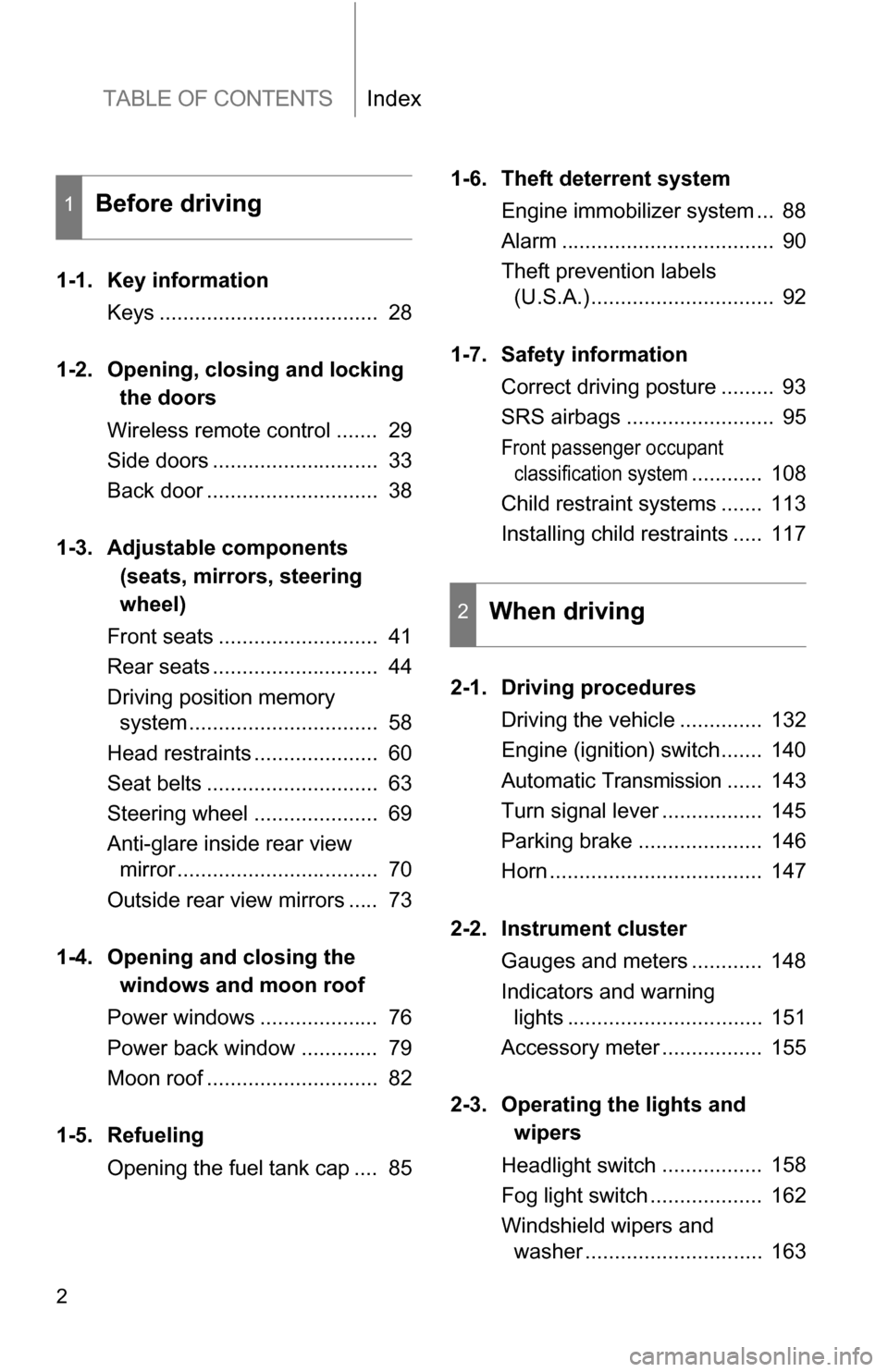
TABLE OF CONTENTSIndex
2
1-1. Key informationKeys ..................................... 28
1-2. Opening, closing and locking
the doors
Wireless remote control ....... 29
Side doors ............................ 33
Back door ............................. 38
1-3. Adjustable components
(seats, mirrors, steering
wheel)
Front seats ........................... 41
Rear seats ............................ 44
Driving position memory system ................................ 58
Head restraints ..................... 60
Seat belts ............................. 63
Steering wheel ..................... 69
Anti-glare inside rear view mirror .................................. 70
Outside rear view mirrors ..... 73
1-4. Opening a nd closing the
windo ws and moon roof
Power windows .................... 76
Power back window ............. 79
Moon roof ............................. 82
1-5. Refueling Opening the fuel tank cap .... 85 1-6. Theft deterrent system
Engine immobilizer system ... 88
Alarm .................................... 90
Theft prevention labels (U.S.A.)............................... 92
1-7. Safety information Correct driving posture ......... 93
SRS airbags ......................... 95
Front passenger occupant classification system
............ 108
Child restraint systems ....... 113
Installing child restraints ..... 117
2-1. Driving procedures Driving the vehicle .............. 132
Engine (ignition) switch....... 140
Automatic
Transmission...... 143
Turn signal lever ................. 145
Parking brake ..................... 146
Horn .................................... 147
2-2. Instrument cluster Gauges and meters ............ 148
Indicators and warning lights ................................. 151
Accessory meter ................. 155
2-3. Operating the li ghts and
wipers
Headlight switch ................. 158
Fog light switch ................... 162
Windshield wipers and washer .............................. 163
1Before driving
2When driving
Page 5 of 520
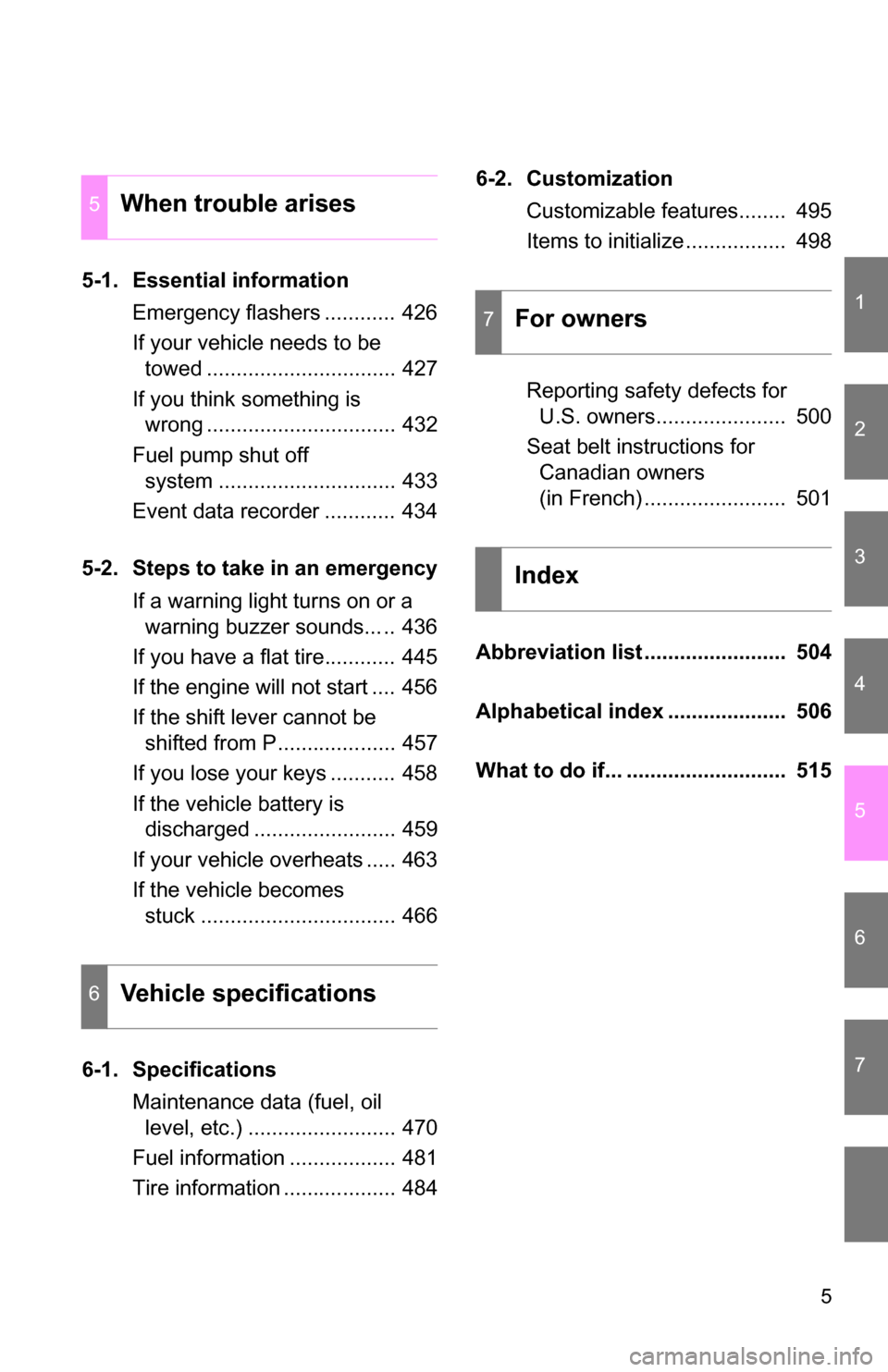
1
2
3
4
5
6
7
5
5-1. Essential informationEmergency flashers ............ 426
If your vehicle needs to be towed ................................ 427
If you think something is wrong ................................ 432
Fuel pump shut off system .............................. 433
Event data recorder ............ 434
5-2. Steps to take in an emergency If a warning light turns on or a warning buzzer sounds... .. 436
If you have a flat tire............ 445
If the engine will not start .... 456
If the shift lever cannot be shifted from P.................... 457
If you lose your keys ........... 458
If the vehicle battery is discharged ........................ 459
If your vehicle overheats ..... 463
If the vehicle becomes stuck ................................. 466
6-1. Specifications Maintenance data (fuel, oil level, etc.) ......................... 470
Fuel information .................. 481
Tire information ................... 484 6-2. Customization
Customizable features........ 495
Items to initialize ................. 498
Reporting safety defects for U.S. owners...................... 500
Seat belt instructions for Canadian owners
(in French) ........................ 501
Abbreviation list ........................ 504
Alphabetical index .................... 506
What to do if... ........................... 515
5When trouble arises
6Vehicle specifications
7For owners
Index
Page 7 of 520

7
Tires
●Rotation
● Replacement
● Inflation pressure
● Information
P. 389
P. 445
P. 395
P. 484
Fuel filler door P. 85
Rear turn signal lights P. 145
Stop/tail and rear side marker lightsP. 158
Side doors P. 33
: If equipped
Back door P. 38
License plate lights P. 158
Rear window wiper P. 165
Rear window
defogger
P. 240
Back window P. 79
Roof luggage carrier P. 203
Page 14 of 520
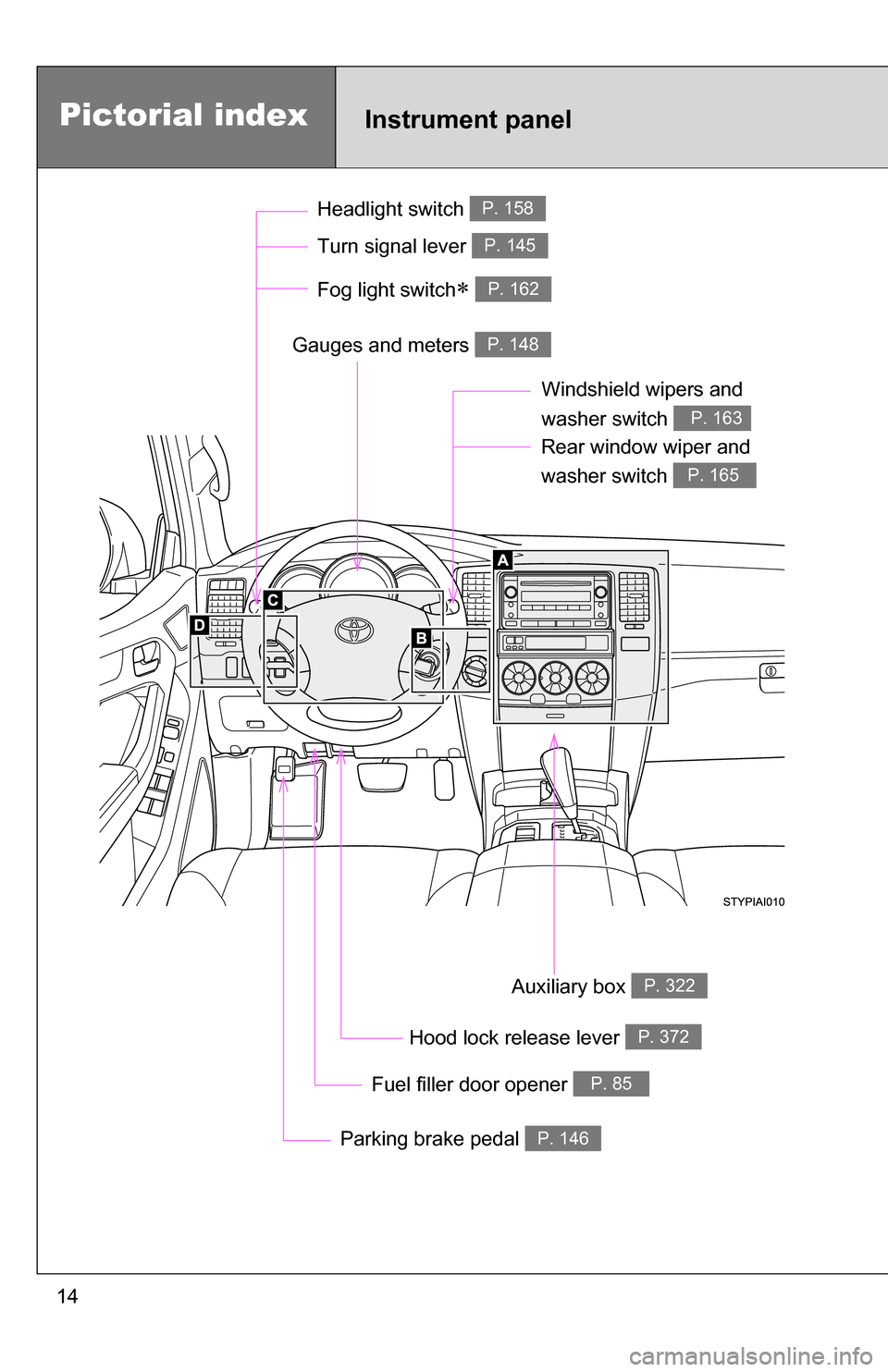
14
Pictorial indexInstrument panel
Headlight switch P. 158
Windshield wipers and
washer switch
P. 163
Fuel filler door opener P. 85
Gauges and meters P. 148
Hood lock release lever P. 372
Rear window wiper and
washer switch
P. 165
Turn signal lever P. 145
Fog light switch P. 162
Auxiliary box P. 322
Parking brake pedal P. 146
Page 22 of 520
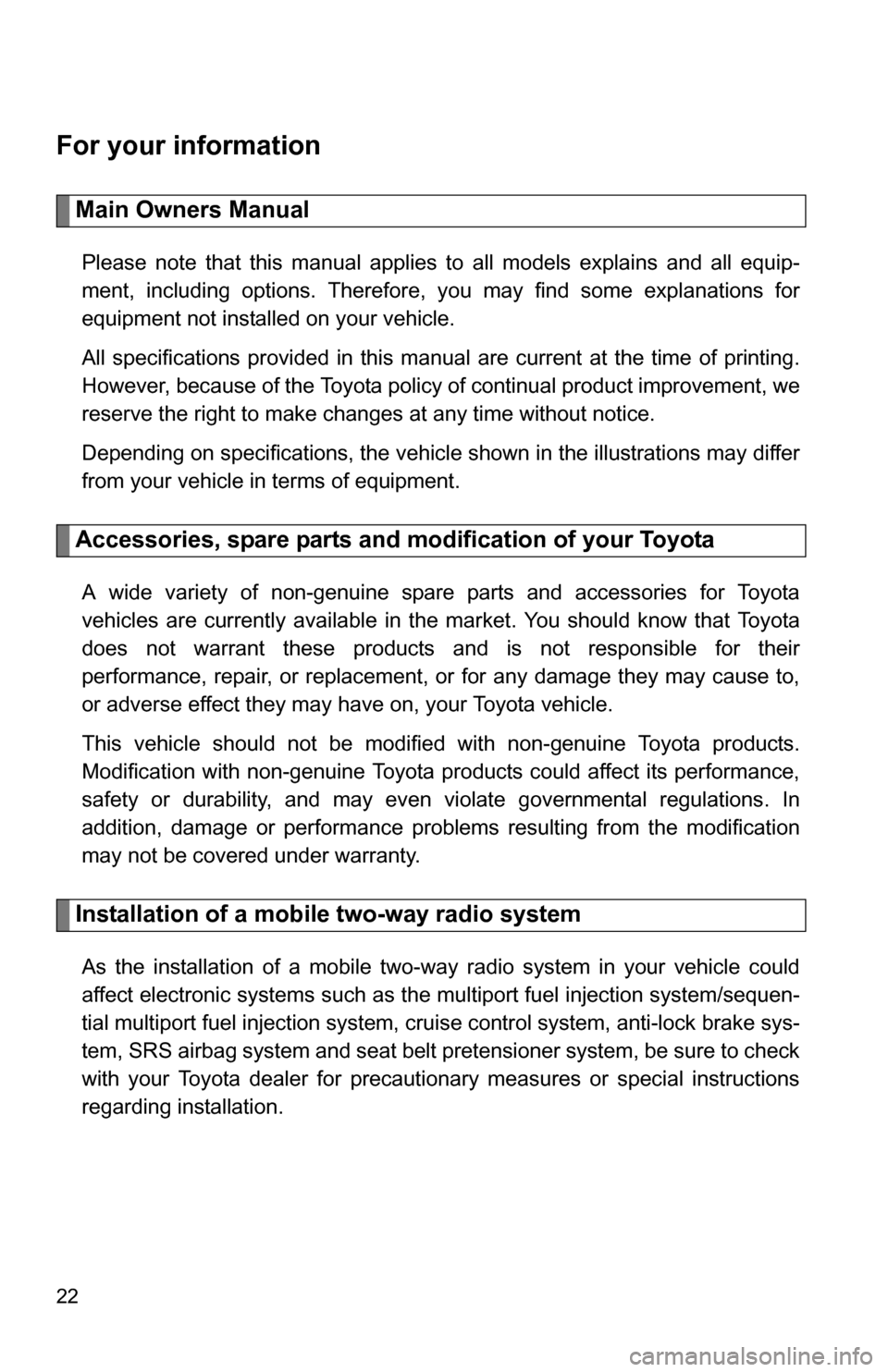
22
For your information
Main Owners Manual
Please note that this manual applies to all models explains and all equip-
ment, including options. Therefore, you may find some explanations for
equipment not installed on your vehicle.
All specifications provided in this manual are current at the time of printing.
However, because of the Toyota policy of continual product improvement, we
reserve the right to make changes at any time without notice.
Depending on specifications, the vehicle shown in the illustrations may differ
from your vehicle in terms of equipment.
Accessories, spare parts and modification of your Toyota
A wide variety of non-genuine spare parts and accessories for Toyota
vehicles are currently available in the market. You should know that Toyota
does not warrant these products and is not responsible for their
performance, repair, or replacement, or for any damage they may cause to,
or adverse effect they may have on, your Toyota vehicle.
This vehicle should not be modified with non-genuine Toyota products.
Modification with non-genuine Toyota products could affect its performance,
safety or durability, and may even violate governmental regulations. In
addition, damage or performance problems resulting from the modification
may not be covered under warranty.
Installation of a mobile two-way radio system
As the installation of a mobile two-way radio system in your vehicle could
affect electronic systems such as the multiport fuel injection system/sequen-
tial multiport fuel injection system, cruise control system, anti-lock brake sys-
tem, SRS airbag system and seat belt pretensioner system, be sure to check
with your Toyota dealer for precautionary measures or special instructions
regarding installation.
Page 27 of 520

Before driving1
27
1-1. Key informationKeys ................................... 28
1-2. Opening, closing and
locking the doors
Wireless remote control ..... 29
Side doors .......................... 33
Back door ........................... 38
1-3. Adjustable components
(seats, mirrors,
steering wheel)
Front seats ......................... 41
Rear seats.......................... 44
Driving position memory system ............................. 58
Head restraints................... 60
Seat belts ........................... 63
Steering wheel ................... 69
Anti-glare inside rear view mirror ............................... 70
Outside rear view mirrors ... 73
1-4. Opening and clos ing
the windows and
moo n roof
Power windows .................. 76
Power back window ........... 79
Moon roof ........................... 82
1-5. Refueling Opening the fuel tank cap ........................... 85 1-6. Theft deterrent system
Engine immobilizer system ............................. 88
Alarm.................................. 90
Theft prevention labels (U.S.A.) ............................ 92
1-7. Safety information Correct driving posture....... 93
SRS airbags ....................... 95
Front passenger occupant classification system ...... 108
Child restraint systems..... 113
Installing child restraints... 117
Page 85 of 520
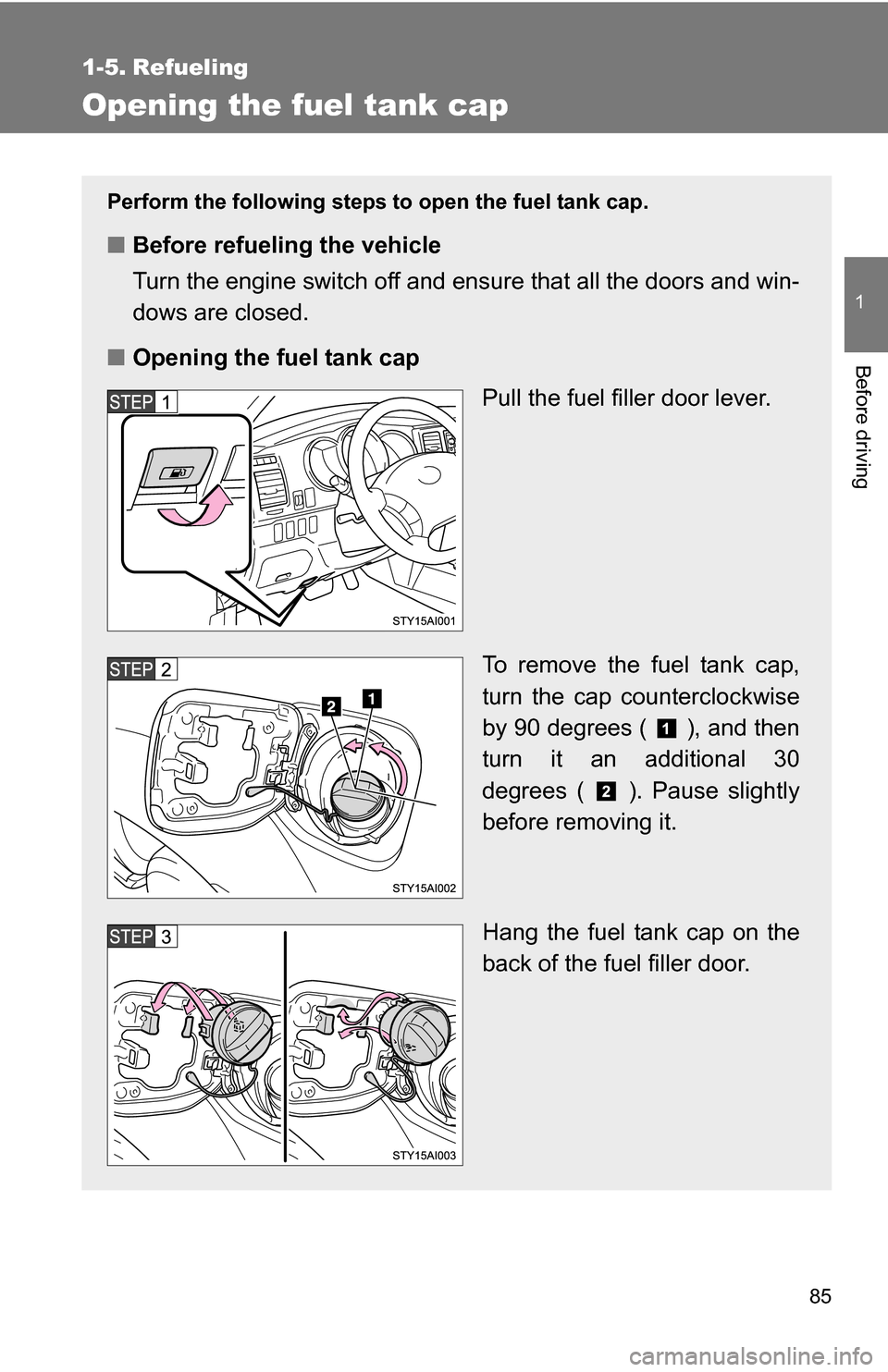
85
1
Before driving
1-5. Refueling
Opening the fuel tank cap
Perform the following steps to open the fuel tank cap.
■Before refueling the vehicle
Turn the engine switch off and ensure that all the doors and win-
dows are closed.
■ Opening the fuel tank cap
Pull the fuel filler door lever.
To remove the fuel tank cap,
turn the cap counterclockwise
by 90 degrees ( ), and then
turn it an additional 30
degrees ( ). Pause slightly
before removing it.
Hang the fuel tank cap on the
back of the fuel filler door.
Page 86 of 520
![TOYOTA 4RUNNER 2009 N280 / 5.G Owners Manual 86 1-5. Refueling
Closing the fuel tank capWhen replacing the fuel tank
cap, turn it until a clicking sound
is heard.
■Fuel types
Use unleaded gasoline. (Octane rating 87 [Research Octane Number 91] TOYOTA 4RUNNER 2009 N280 / 5.G Owners Manual 86 1-5. Refueling
Closing the fuel tank capWhen replacing the fuel tank
cap, turn it until a clicking sound
is heard.
■Fuel types
Use unleaded gasoline. (Octane rating 87 [Research Octane Number 91]](/img/14/6094/w960_6094-85.png)
86 1-5. Refueling
Closing the fuel tank capWhen replacing the fuel tank
cap, turn it until a clicking sound
is heard.
■Fuel types
Use unleaded gasoline. (Octane rating 87 [Research Octane Number 91] or
higher)
■ Fuel tank capacity
Approximately 23.0 gal. (87.0 L, 19.1 Imp. gal.)
CAUTION
■Refueling the vehicle
Observe the following precautions while refueling the vehicle.
Failure to do so may result in death or serious injury.
●Touch the vehicle or some other metal surface to discharge any static
electricity.
Sparks resulting from discharging static electricity may cause the fuel
vapors to ignite.
● Always hold the grips on the fuel tank cap and turn it slowly to remove it.
A whooshing sound may be heard when the fuel tank cap is loosened.
Wait until the sound cannot be heard before fully removing the cap.
In hot weather, pressurized fuel may spray out of the filler neck and cause
injury.
● Do not allow anyone that has not discharged static electricity from their
bodies to come close to an open fuel tank.
Page 87 of 520
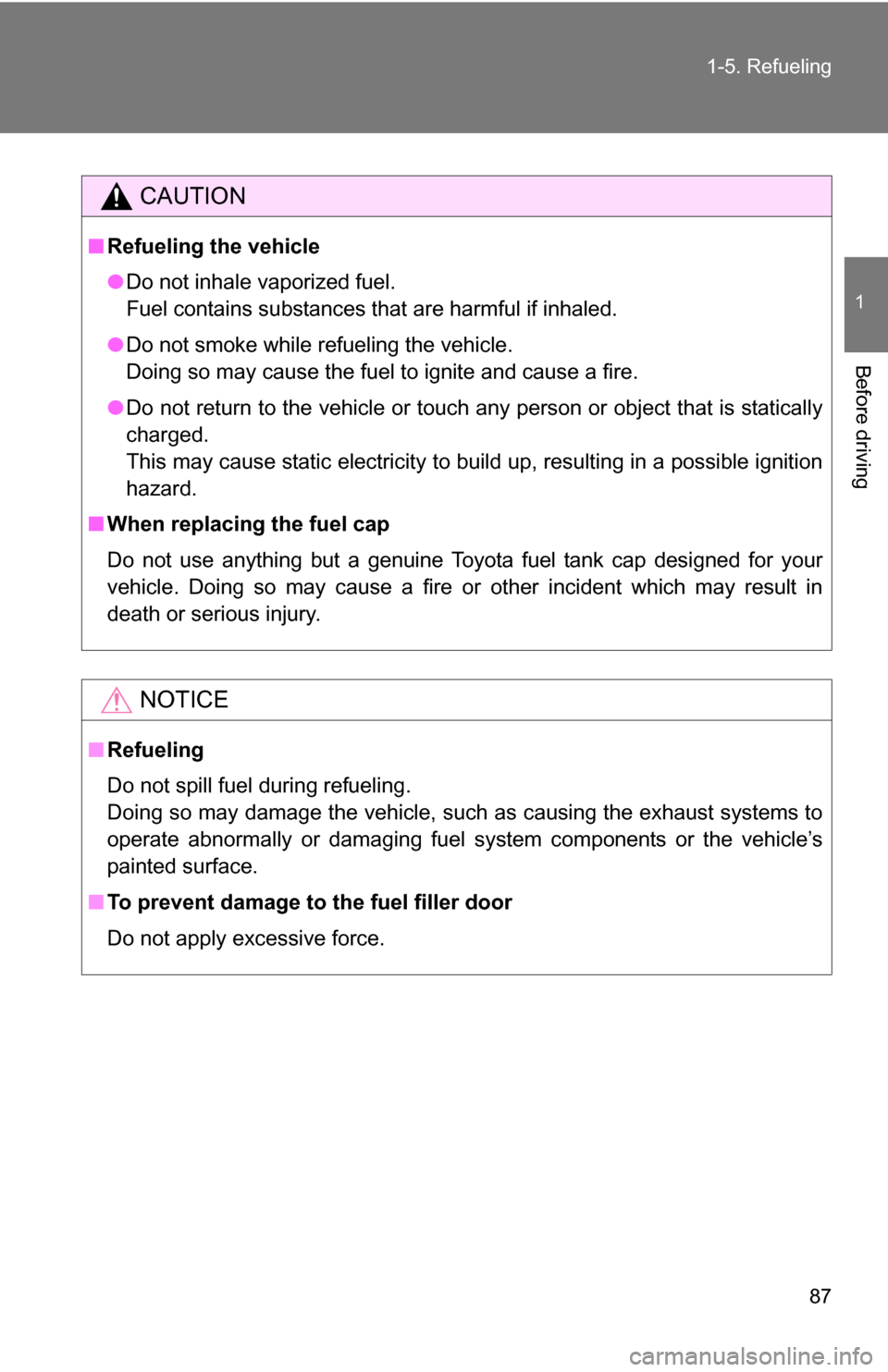
87
1-5. Refueling
1
Before driving
CAUTION
■
Refueling the vehicle
●Do not inhale vaporized fuel.
Fuel contains substances that are harmful if inhaled.
● Do not smoke while refueling the vehicle.
Doing so may cause the fuel to ignite and cause a fire.
● Do not return to the vehicle or touch any person or object that is statically
charged.
This may cause static electricity to build up, resulting in a possible ignition
hazard.
■ When replacing the fuel cap
Do not use anything but a genuine Toyota fuel tank cap designed for your
vehicle. Doing so may cause a fire or other incident which may result in
death or serious injury.
NOTICE
■Refueling
Do not spill fuel during refueling.
Doing so may damage the vehicle, such as causing the exhaust systems to
operate abnormally or damaging fuel s ystem components or the vehicle’s
painted surface.
■ To prevent damage to the fuel filler door
Do not apply excessive force.
Page 133 of 520
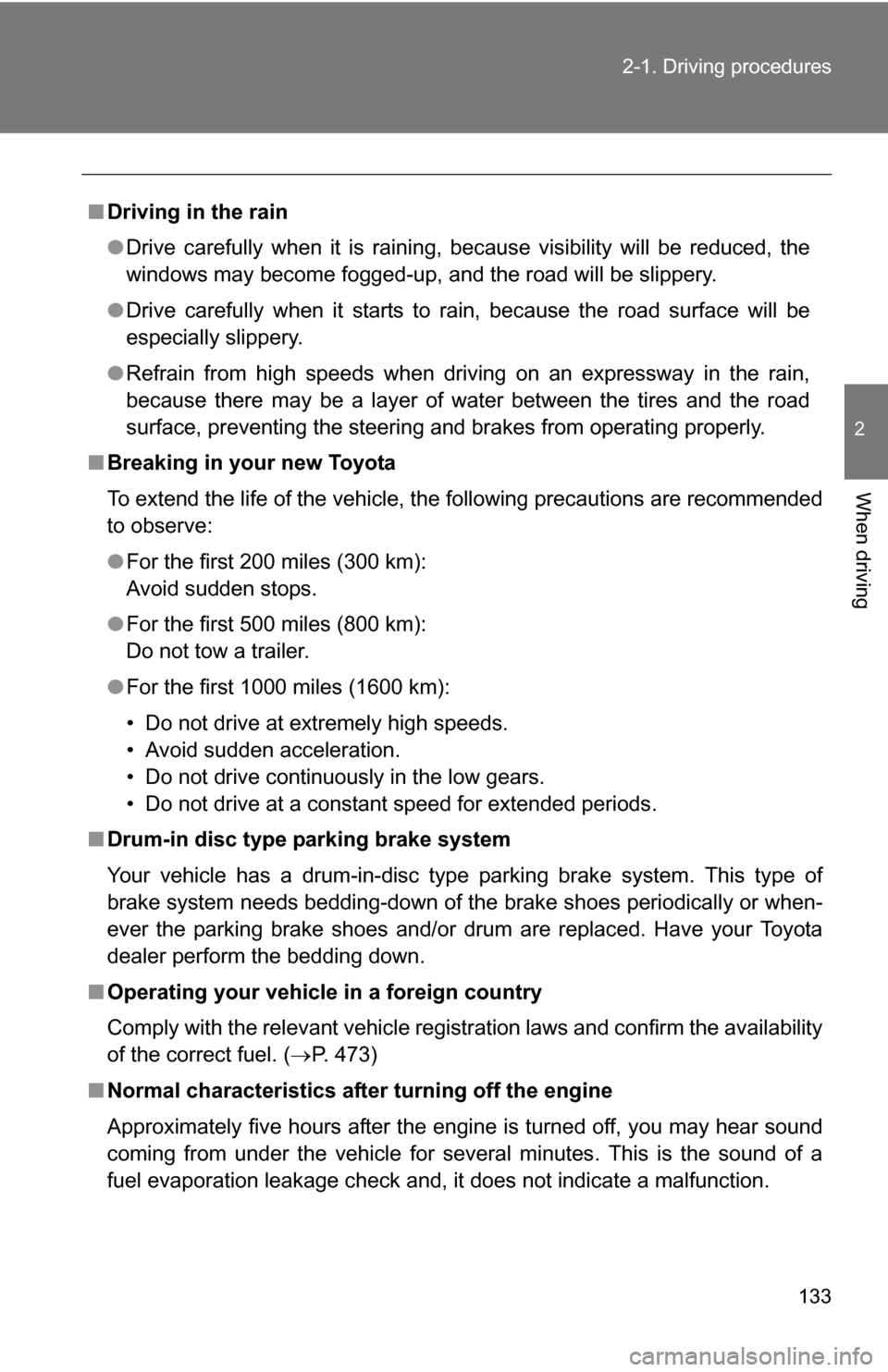
133
2-1. Driving procedures
2
When driving
■
Driving in the rain
●Drive carefully when it is raining, because visibility will be reduced, the
windows may become fogged-up, and the road will be slippery.
● Drive carefully when it starts to rain, because the road surface will be
especially slippery.
● Refrain from high speeds when driving on an expressway in the rain,
because there may be a layer of water between the tires and the road
surface, preventing the steering and brakes from operating properly.
■ Breaking in your new Toyota
To extend the life of the vehicle, the following precautions are recommended
to observe:
●For the first 200 miles (300 km):
Avoid sudden stops.
● For the first 500 miles (800 km):
Do not tow a trailer.
● For the first 1000 miles (1600 km):
• Do not drive at extremely high speeds.
• Avoid sudden acceleration.
• Do not drive continuously in the low gears.
• Do not drive at a constant speed for extended periods.
■ Drum-in disc type parking brake system
Your vehicle has a drum-in-disc type parking brake system. This type of
brake system needs bedding-down of the brake shoes periodically or when-
ever the parking brake shoes and/or drum are replaced. Have your Toyota
dealer perform the bedding down.
■ Operating your vehicle in a foreign country
Comply with the relevant vehicle registration laws and confirm the availability
of the correct fuel. ( P. 473)
■ Normal characteristics afte r turning off the engine
Approximately five hours after the engine is turned off, you may hear sound
coming from under the vehicle for several minutes. This is the sound of a
fuel evaporation leakage check and, it does not indicate a malfunction.